Hydroxocobalamin (Vitamin B12) Injection
Product Overview
Hydroxocobalamin (Vitamin B12) Injection is a compounded sterile solution of hydroxocobalamin, a form of vitamin B₁₂, typically supplied at a concentration of 2 mg/mL in a 10 mL vial.[1]
This medication is available through both 503A compounding pharmacies and 503B outsourcing facilities, meaning it can be prepared for individual prescriptions or in bulk for office use.[2]
Hydroxocobalamin is administered via intramuscular or intravenous injection to treat and prevent vitamin B₁₂ deficiency, particularly in conditions like pernicious anemia where oral B₁₂ absorption is impaired.
By restoring cobalamin levels, these injections help support healthy red blood cell production, neurological function, and DNA synthesis.[3]
Dosing of hydroxocobalamin should be individualized based on the severity of vitamin B₁₂ deficiency and clinical response.
For vitamin B₁₂ deficiency (e.g., pernicious anemia), a common regimen is to begin with frequent intramuscular injections to replenish body stores.
A typical loading dose is 1,000 mcg (1 mg) administered intramuscularly several times per week (such as every other day or 3 times per week) for a couple of weeks.
After initial repletion, a maintenance dose is given, often 1,000 mcg intramuscularly every month or every 2 to 3 months, to prevent recurrence of deficiency.[7]
In practice, some protocols use 1 mg IM monthly for maintenance once levels are stabilized.
Hydroxocobalamin may also be given intravenously in certain scenarios (for example, 5 g IV for acute cyanide poisoning antidote therapy), but such high-dose use is in emergency settings and distinct from routine deficiency treatment.
The dosing schedule should be determined by a healthcare provider, with periodic monitoring of vitamin B₁₂ levels and clinical symptoms to adjust therapy as needed.
Hydroxocobalamin is a precursor of the active coenzyme forms of vitamin B₁₂ (methylcobalamin and adenosylcobalamin).
Once injected, it is converted into these active forms, which serve as essential cofactors in key metabolic processes such as DNA synthesis, fatty acid metabolism, and neuronal myelin formation.[4]
In patients with cyanide poisoning, hydroxocobalamin also acts as an antidote by binding to cyanide ions with high affinity to form nontoxic cyanocobalamin.
This cyanocobalamin complex is then excreted in the urine, thereby detoxifying the cyanide and restoring cellular respiratory function.[5]
The primary contraindication for hydroxocobalamin injection is a known hypersensitivity to hydroxocobalamin, cobalt, or any component of the formulation.
Patients with a history of allergy to vitamin B₁₂ or cobalt should not receive this injection.
There are no other absolute contraindications reported for hydroxocobalamin use in deficiency states, but caution is advised in individuals with conditions such as early Leber’s optic neuropathy (a rare hereditary optic atrophy) due to the theoretical risk of worsening vision.[6]
In all cases, a healthcare provider should evaluate patient history for any contraindication before initiating therapy.
Hydroxocobalamin has relatively few major drug interactions.
However, certain medications can affect its efficacy. For example, concurrent use of chloramphenicol (an antibiotic) may attenuate the hematologic response to vitamin B₁₂ therapy.
Large doses of folic acid may also partially mask or worsen vitamin B₁₂ deficiency by correcting anemia while allowing neurological damage to progress.[7]
In addition, oral contraceptives have been noted to lower serum B₁₂ levels, though this effect is usually clinically insignificant.[7]
It is advisable for patients to inform their healthcare provider of all medications and supplements they are taking, so that potential interactions can be monitored and managed appropriately.
Most patients tolerate hydroxocobalamin injections well. Common side effects tend to be mild and transient. These may include pain, redness or swelling at the injection site, mild diarrhea, nausea, or itching of the skin.
Some individuals report a sensation of body swelling or warmth, but these symptoms typically resolve on their own within a few hours.[8]
Serious adverse effects are uncommon. Rarely, hypersensitivity reactions can occur, for instance, urticaria (hives) or other allergic-type reactions have been reported in isolated cases.
When hydroxocobalamin is given in high doses (such as during cyanide poisoning treatment), unique effects can be observed: patients often experience a transient reddening of the skin or mucous membranes and a reddish discoloration of the urine due to drug excretion.
High-dose therapy may also cause a brief increase in blood pressure, though this usually returns to baseline within a few hours.[9]
Patients should be advised to contact their healthcare provider if they experience any severe or persistent side effects, such as difficulty breathing, chest tightness, severe rash, or dizziness.
Hydroxocobalamin can be used during pregnancy, and correcting vitamin B₁₂ deficiency is important for the health of both mother and baby.[10]
Vitamin B₁₂ is an essential nutrient for fetal development, and untreated B₁₂ deficiency in a pregnant woman can lead to serious neurological damage in the infant.
No adverse fetal effects have been documented from normal therapeutic doses of hydroxocobalamin in human pregnancies.
However, there are no well-controlled studies in pregnant women, so this medication is generally recommended during pregnancy only when clearly needed.
Very high doses (such as those used for cyanide poisoning) should be used with caution and only if the potential benefit outweighs the risk.
Hydroxocobalamin is classified as Pregnancy Category C in the United States, indicating that risk to the fetus cannot be ruled out in the absence of definitive human data.[11]
In practice, the benefit of treating a true B₁₂ deficiency in pregnancy, preventing anemia and neurological injury, is considered to far outweigh any theoretical risks, under the guidance of a healthcare professional.
Pregnant patients with B₁₂ deficiency should be closely monitored and treated appropriately to ensure healthy outcomes.
Vials of hydroxocobalamin injection should be stored at controlled room temperature (generally 20°-25°C, or 68°-77°F) and protected from light.[13]
Exposure to light can degrade vitamin B₁₂; therefore, the medication is usually kept in its original amber vial or carton until use.
Do not freeze the medication.
Always keep the medication out of reach of children and discard any unused portion after the recommended period, in accordance with safe disposal guidelines.
- Therapeutic Goods Administration. (2022). Hydroxocobalamin injection: Product information. Retrieved March 15, 2025, from https://www.tga.gov.au/resources/prescription-medicines-registered-for-use/hydroxocobalamin-injection
- U.S. Food and Drug Administration. (2023). Compounding and the FDA: Questions and answers. Retrieved March 15, 2025, from https://www.fda.gov/drugs/human-drug-compounding/compounding-and-fda-questions-and-answers
- Ahangar, E. R., & Annamaraju, P. (2023). Hydroxocobalamin. In StatPearls. StatPearls Publishing. https://www.ncbi.nlm.nih.gov/books/NBK470569
- National Institutes of Health, Office of Dietary Supplements. (2024). Vitamin B12: Fact sheet for health professionals. Retrieved March 15, 2025, from https://ods.od.nih.gov/factsheets/VitaminB12-HealthProfessional
- Maryland Poison Center. (2018). Hydroxocobalamin (Cyanokit®) antidote facts. Retrieved March 15, 2025, from https://mdpoison.com/Newsletter/ToxTidbits/Cyanokit.pdf
- Drugs..com. (2023). Hydroxocobalamin: Professional patient advice. https://www.drugs.com/pro/hydroxocobalamin.html
- Medsafe. (2019). Neo-B12 injection (hydroxocobalamin) data sheet. Retrieved March 15, 2025, from https://www.medsafe.govt.nz/profs/Datasheet/n/Neo-B12inj.pdf
- National Health Service. (2024). Side effects of hydroxocobalamin. Retrieved March 15, 2025, from https://www.nhs.uk/medicines/hydroxocobalamin/side-effects
- Drugs..com. (2023). Hydroxocobalamin: Adverse reactions (IV use). https://www.drugs.com/sfx/hydroxocobalamin-side-effects.html
- National Health Service. (2024). Hydroxocobalamin and pregnancy. Retrieved March 15, 2025, from https://www.nhs.uk/medicines/hydroxocobalamin/pregnancy-breastfeeding
- Drugs..com. (2023). Hydroxocobalamin: Pregnancy warnings. https://www.drugs.com/pregnancy/hydroxocobalamin.html
- Drugs..com. (2023). Hydroxocobalamin: Dosage and administration. https://www.drugs.com/dosage/hydroxocobalamin.html
- American Regent, Inc. (2018). Cyanocobalamin injection, USP: Package insert. https://www.drugs.com/pro/cyanocobalamin.html
- Cleveland Clinic. (2022). Vitamin B12 deficiency: Symptoms, causes & treatment. https://my.clevelandclinic.org/health/diseases/14816-vitamin-b12-deficiency
- Seattle Beauty. (2023). Understanding vitamin B12: Hydroxocobalamin vs. cyanocobalamin. Retrieved March 15, 2025, from https://seattlebeauty.org/vitamin-b12-guide
- National Health Service. (2024). Having your hydroxocobalamin injection. Retrieved March 15, 2025, from https://www.nhs.uk/medicines/hydroxocobalamin/how-hydroxocobalamin-injection-is-given
- Hertfordshire Colonic Health. (2021). Vitamin B12 injections - FAQs. Retrieved March 15, 2025, from https://hertfordshirecolonics.co.uk/b12-injections-faq
- Cleveland Clinic. (2021). Hydroxocobalamin injection: Patient education sheet. https://my.clevelandclinic.org/health/drugs/21328-hydroxocobalamin-injection
What is Hydroxocobalamin (Vitamin B₁₂) Injection used for?
Hydroxocobalamin injection is primarily used to treat or prevent vitamin B₁₂ deficiency in patients.
It is often prescribed for individuals with pernicious anemia or other conditions that impair B₁₂ absorption (for example, after gastric surgery or in certain digestive disorders).[14]
By injecting hydroxocobalamin, vitamin B₁₂ levels can be restored, helping to resolve anemia, fatigue, neurological symptoms, and other complications of B₁₂ deficiency.
In addition, hydroxocobalamin may be used as part of the treatment for cyanide poisoning (as an antidote), although in such emergency cases very high doses are administered under hospital care.
How is hydroxocobalamin different from cyanocobalamin?
Cyanocobalamin and hydroxocobalamin are two forms of vitamin B₁₂.
Cyanocobalamin is a synthetic form of B₁₂ that contains a cyanide group, whereas hydroxocobalamin is a naturally occurring form produced by bacteria.
Hydroxocobalamin tends to remain in the body longer and is more readily converted to the active coenzyme forms of B₁₂, which can make it effective for maintaining B₁₂ levels.[15]
In practice, hydroxocobalamin injections achieve higher and more sustained vitamin B₁₂ concentrations compared to cyanocobalamin.
Cyanocobalamin is more commonly found in oral supplements and fortified foods, and while it is effective for many people, some practitioners prefer hydroxocobalamin for injections due to its natural form and longer retention.
Both forms ultimately provide vitamin B₁₂ activity, but hydroxocobalamin’s longer duration in the body means injections can be given less frequently in maintenance therapy.
How often do I need to take hydroxocobalamin injections?
The frequency of hydroxocobalamin injections depends on the indication and the patient’s B₁₂ levels. For treating a deficiency, injections are usually given frequently at the start, for example, several times per week or every other day for a couple of weeks, to quickly build up body stores.[16]
After this initial phase, the frequency is reduced. Many patients then receive maintenance injections about once a month (or in some cases every 2-3 months) to keep their vitamin B₁₂ levels in the normal range.[12] Your healthcare provider will determine the appropriate schedule based on your specific needs and response to treatment.
It’s important to attend all scheduled injections because skipping doses could allow B₁₂ levels to fall again.
Patients with pernicious anemia or others who cannot absorb B₁₂ from food typically need lifelong B₁₂ therapy, often on a monthly injection schedule.
What are the common side effects of these injections?
The injections are generally well-tolerated. Common side effects are usually mild and temporary. They include pain or redness at the injection site, slight swelling or tenderness, mild diarrhea, and sometimes itching or a generalized feeling of body swelling.[17]
These effects, if they occur, tend to resolve within a short time. Most people do not experience significant side effects from hydroxocobalamin.
If you do notice any reaction at the injection site (such as warmth or a small lump), it can help to gently apply a cool compress.
Remember, serious side effects are very rare; if you develop symptoms like hives, difficulty breathing, chest tightness, or severe dizziness after an injection, seek medical attention, as those could indicate an allergic reaction (which is extremely uncommon).
Can I take hydroxocobalamin while on other medications or supplements?
In most cases, yes. Hydroxocobalamin does not have many significant drug interactions.
However, certain medications might influence how well the vitamin B₁₂ injection works. For example, if you are taking chloramphenicol, an antibiotic, it could interfere with the blood-building response to the B₁₂ injection.
Some chemotherapy drugs or antiretroviral medications (for HIV) that suppress bone marrow might also blunt the effectiveness of B₁₂ therapy.[18]
Additionally, very high doses of folic acid could potentially mask a B₁₂ deficiency, so it’s important your doctor knows about any folate supplements you take.
It’s always a good practice to inform your healthcare provider about all medicines, vitamins, and supplements you are using. They will advise you if any adjustments or monitoring are needed.
In general, no common foods or over-the-counter products significantly reduce the effectiveness of hydroxocobalamin injections, but your provider will manage any potential.
Administration Instructions
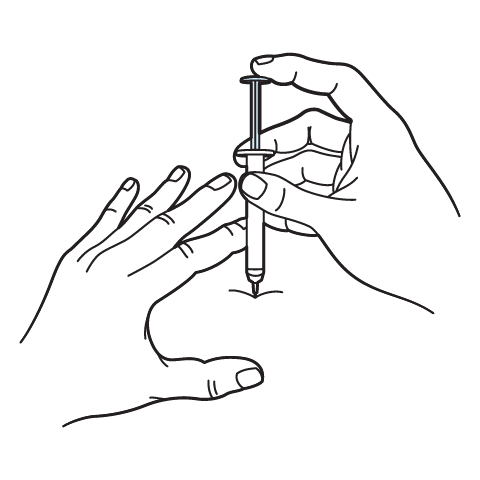
Intramuscular Injection Instructions

Subcutaneous Injection Instructions
503A vs 503B
- 503A pharmacies compound products for specific patients whose prescriptions are sent by their healthcare provider.
- 503B outsourcing facilities compound products on a larger scale (bulk amounts) for healthcare providers to have on hand and administer to patients in their offices.
Frequently asked questions
Our team of experts has the answers you're looking for.
A clinical pharmacist cannot recommend a specific doctor. Because we are licensed in all 50 states*, we can accept prescriptions from many licensed prescribers if the prescription is written within their scope of practice and with a valid patient-practitioner relationship.
*Licensing is subject to change.
Each injectable IV product will have the osmolarity listed on the label located on the vial.
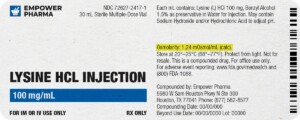
Given the vastness and uniqueness of individualized compounded formulations, it is impossible to list every potential compound we offer. To inquire if we currently carry or can compound your prescription, please fill out the form located on our Contact page or call us at (877) 562-8577.
We source all our medications and active pharmaceutical ingredients from FDA-registered suppliers and manufacturers.

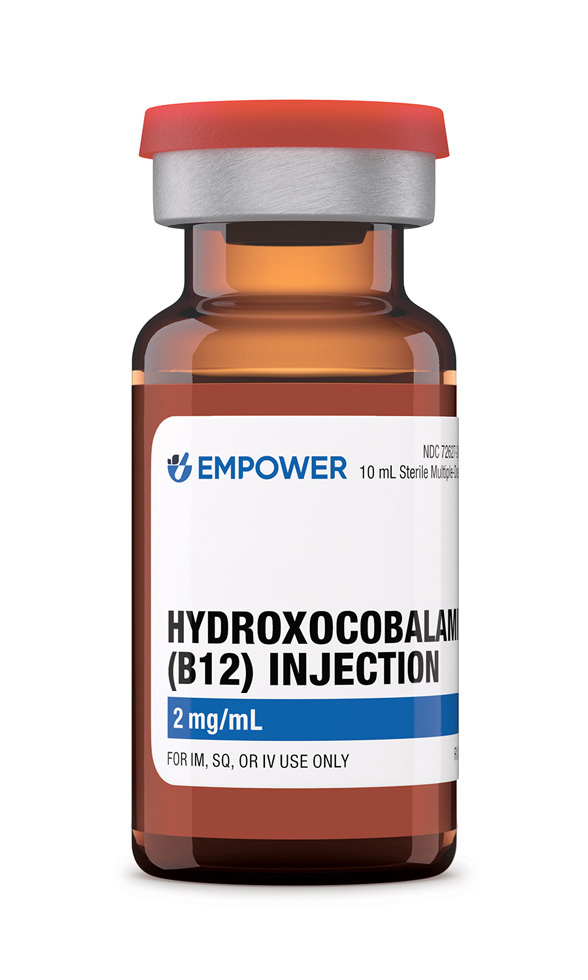
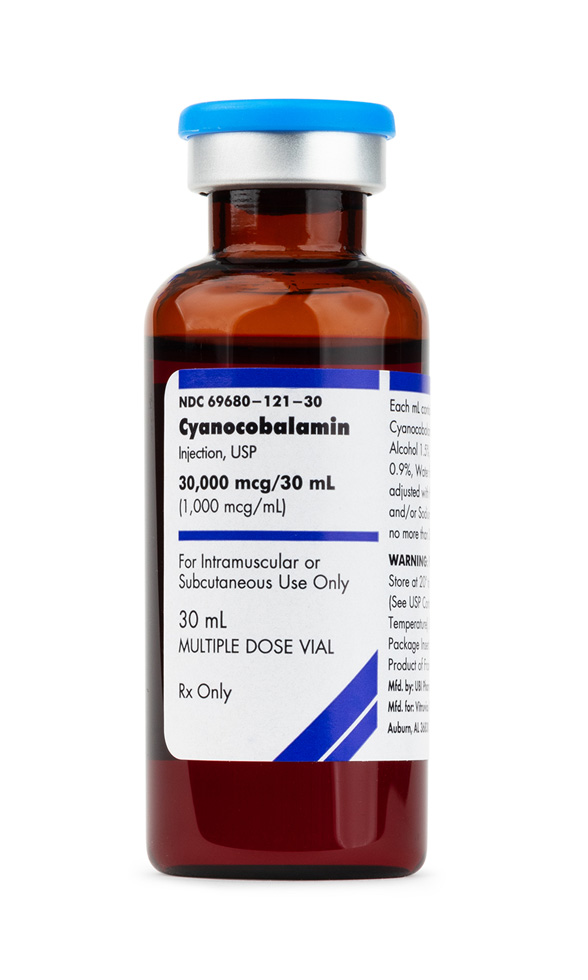 Cyanocobalamin (Vitamin B12) Injection
Cyanocobalamin (Vitamin B12) Injection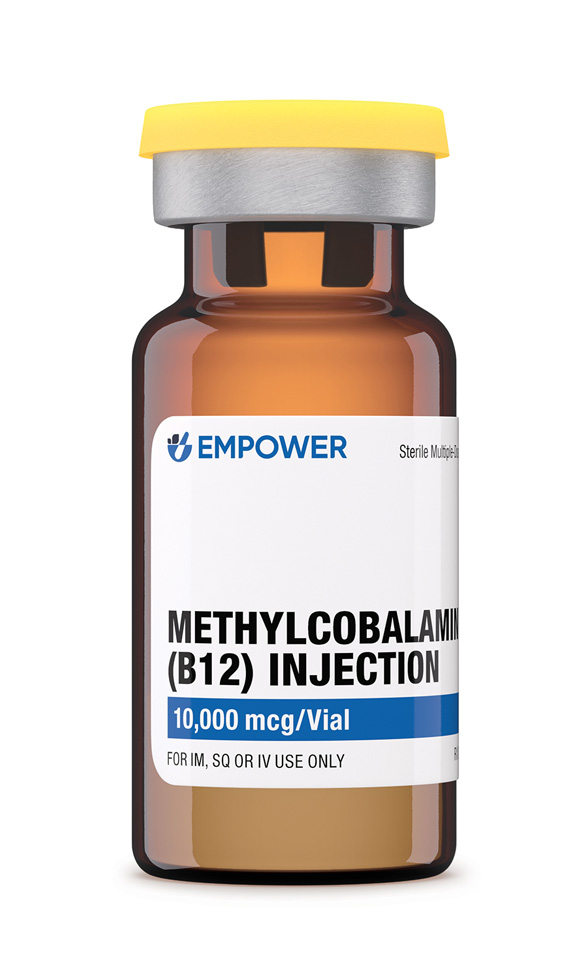 Methylcobalamin Injection (Vitamin B12)
Methylcobalamin Injection (Vitamin B12)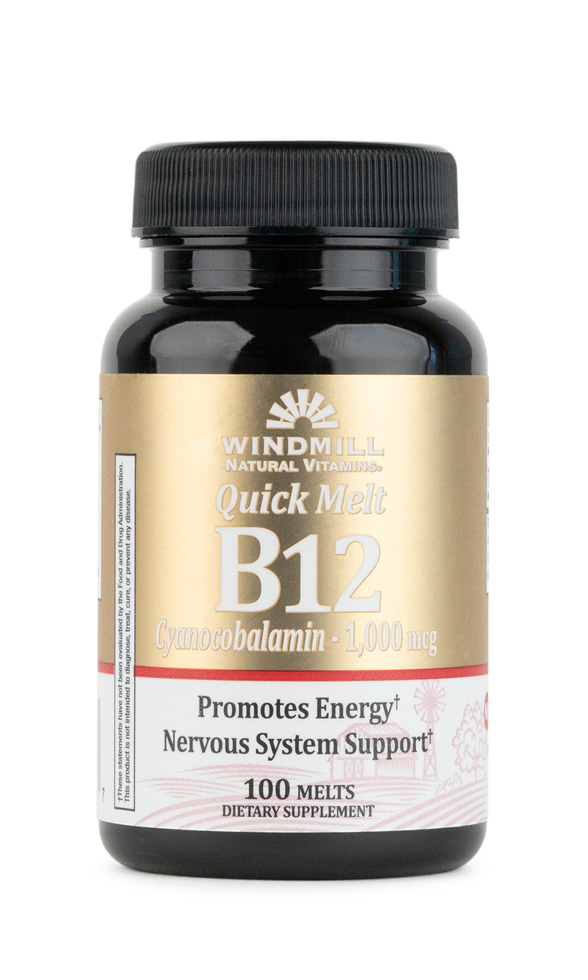 Cyanocobalamin Tablets
Cyanocobalamin Tablets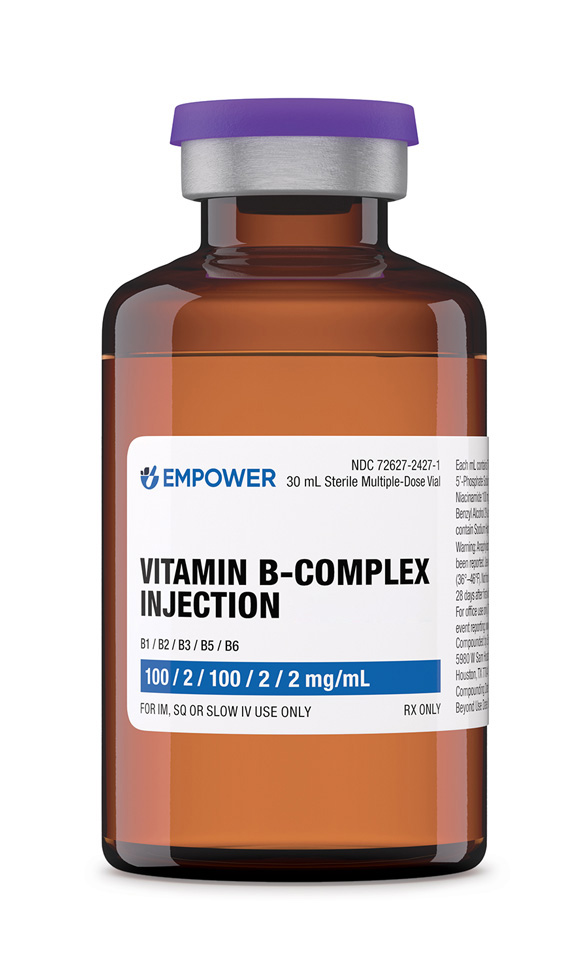 Vitamin B-Complex Injection
Vitamin B-Complex Injection Pyridoxine HCl Injection
Pyridoxine HCl Injection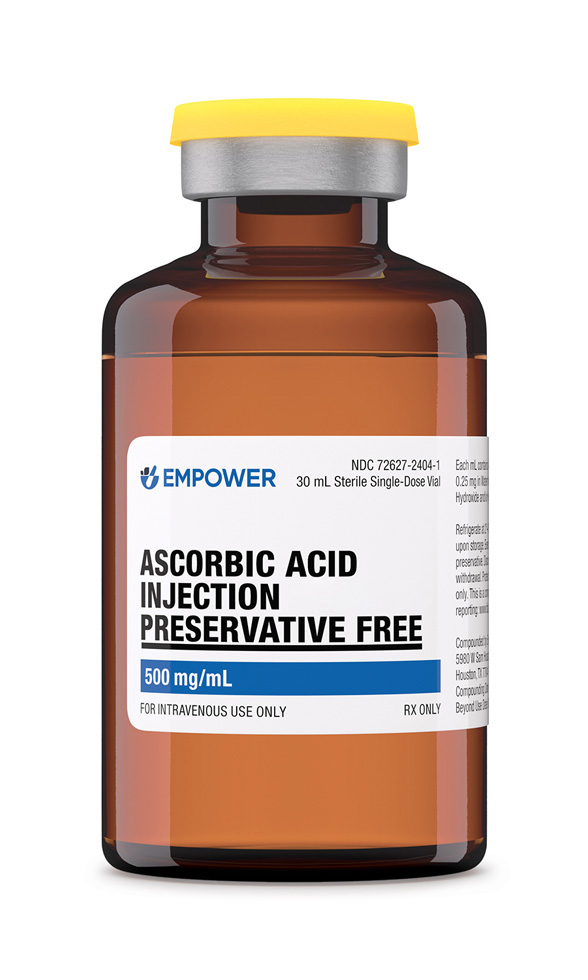 Ascorbic Acid (Vitamin C) Injection
Ascorbic Acid (Vitamin C) Injection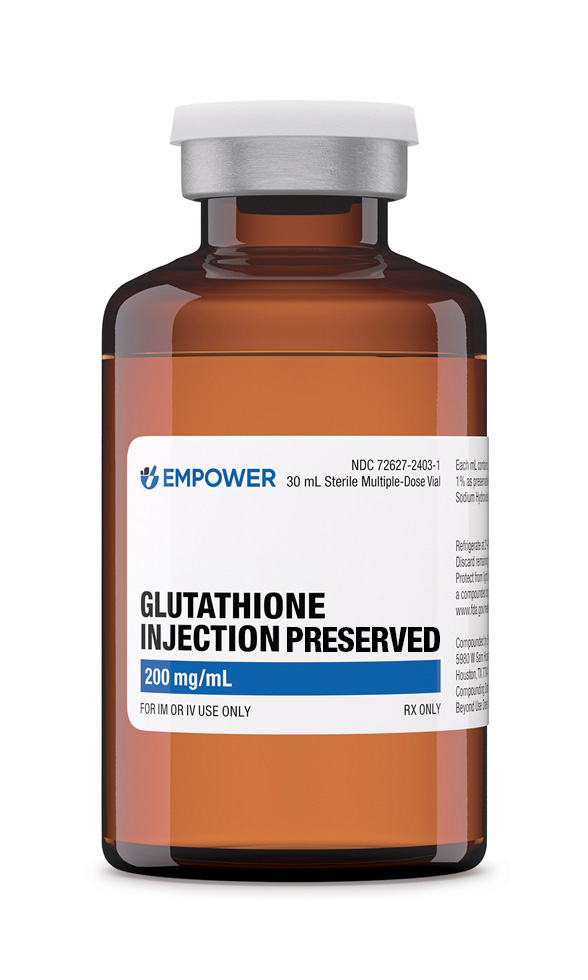 Glutathione Injection
Glutathione Injection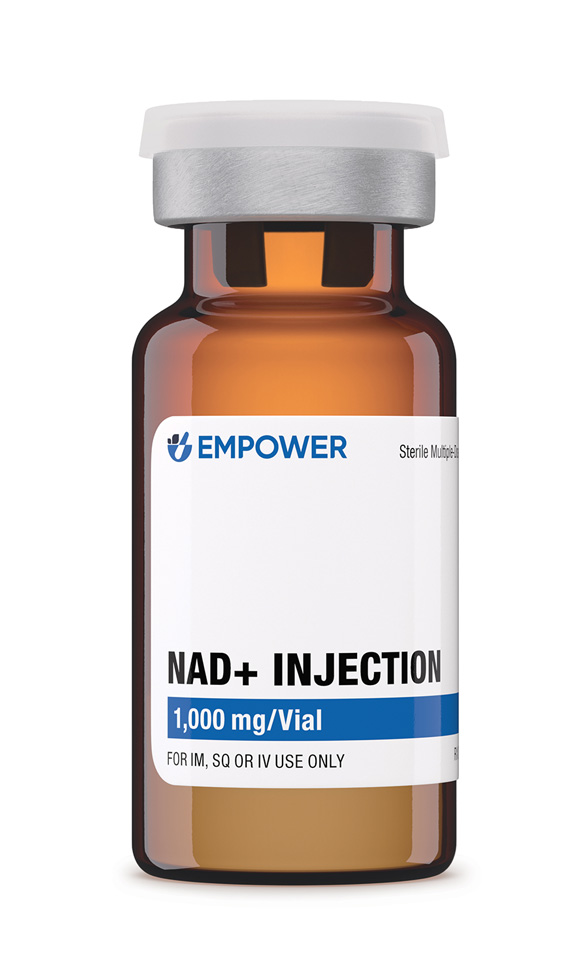 NAD+ Injection (Lyo)
NAD+ Injection (Lyo)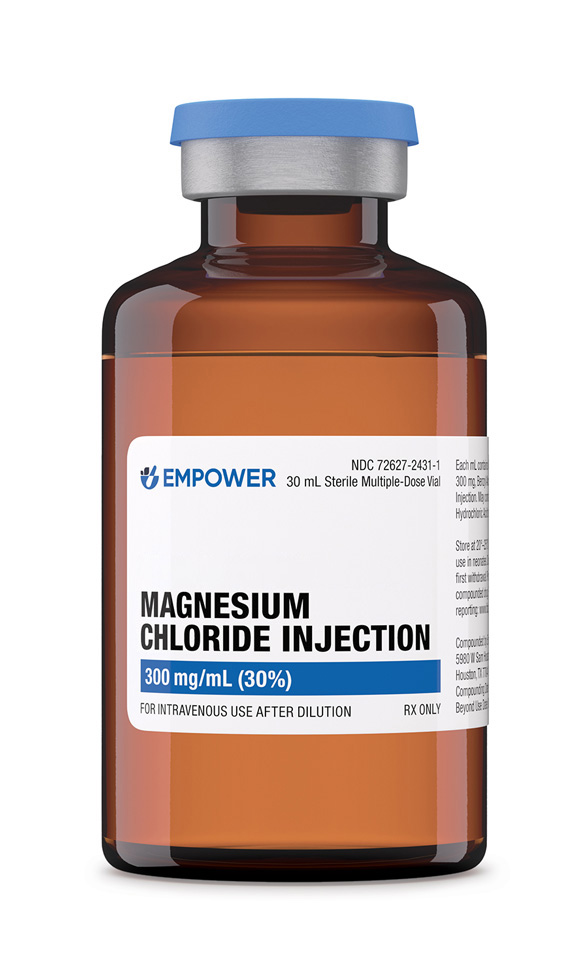 Magnesium Chloride Injection
Magnesium Chloride Injection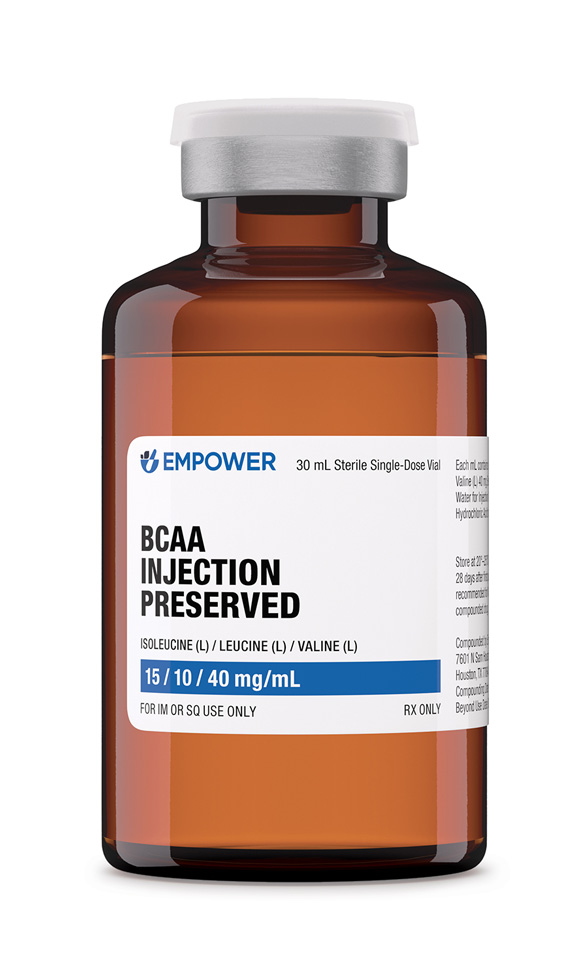 BCAA Injection
BCAA Injection